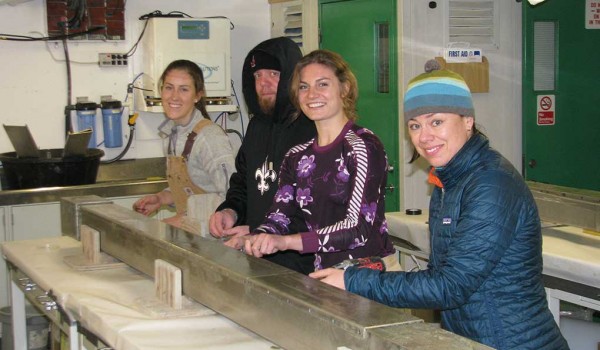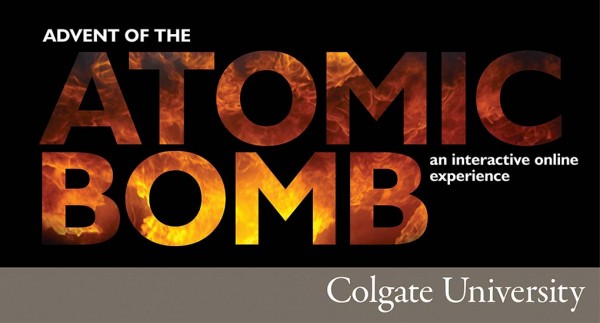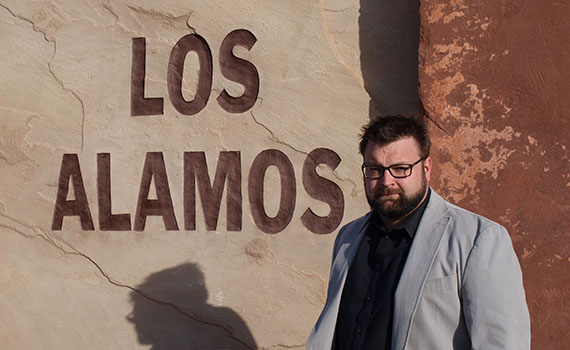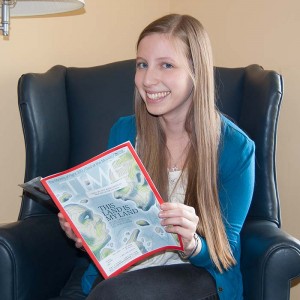National Model African Union
When Neal Barsch ’14 found out he would be representing Sierra Leone at the National Model African Union in Washington, D.C., he knew he would need to make some fast friends to accomplish his small country’s diplomatic goals.
“If I wrote a resolution based on just what was good for Sierra Leone, it wouldn’t have passed,” said Barsch, an economics major from Colorado who earned two top honors awarded by his peers at the event.
For Mary Moran, professor of anthropology and Africana and Latin American studies, it is that kind of interaction that makes the Model AU simulation an enriching experience for students of all majors.
“They have to work together. They have to give up on their egos a little to get something done,” Moran said. “And the committee chairs also have to keep order with fifty of their peers in a large conference room with nothing but a gavel and their knowledge of Robert’s Rules of Order.”
“When you walk away, you get the biggest sense of accomplishment, especially when the committee has been run well.”
The event brings students from across the country to simulate a meeting of the real African Union. Each student is assigned a country to represent and is placed in a committee where resolutions are proposed, debated, and acted upon. Colgate has participated in Model AU since the mid-1990s, and in 2010 it became a half-credit course. Students meet weekly to work on resolutions and to study their assigned countries prior to the annual meeting, which took place from February 20–23 this year.
Of the 20 Colgate students participating, seven acted as committee officers, including two chairs and two vice chairs. Lwam Stefanos ’14, a political science and English major from Morristown, N.J., served as vice chair of the Assembly of Heads of State and Government on the final day, as did Gloria Kebirungi ’15, an economics major from Uganda who also served as parliamentarian.
“You’re in the same committee room for eight hours and arguing with forty-three people,” Stefanos said. “When you walk away, you get the biggest sense of accomplishment, especially when the committee has been run well.”
Model AU makes it easier to understand much of the political strife on the continent of Africa, yet the solutions become less obvious, she said. “There are so many things you don’t understand until you take part, specifically when you hear about issues that are hindrances to development in Africa. It’s easy to say something like, ‘We should stop human rights violations in Africa,’ but it’s a different experience when you’re doing it yourself. You realize how complicated it is.”
(Photo by Duy Trinh ’14)
Oh, deer: students study overpopulation problem
Those who live around Colgate are accustomed to steering clear of deer — literally.
The overpopulation of white-tailed deer is a problem that affects the town of Hamilton as well as many other areas. In December, students who researched the issue presented their findings and facilitated a discussion with area residents and local officials. The semester-long project was an integral part of their Community-based Study of Environmental Issues course with biology professor Catherine Cardelus.
Not surprisingly, the students found an overabundance of deer in the area — about four times the size of a healthy population — and an increase in negative interactions between humans and deer. Those include agricultural loss, lack of forest regeneration, higher incidence of Lyme disease in humans, and frequent vehicle accidents. The students had collected data through on-site observations, local surveys, and by looking at communities facing similar issues across the nation.
“We also wanted to determine what the local population thinks about deer,” said Arielle Sperling ’14.
Residents overwhelmingly agreed there is a problem, Cardelus said: “Seventy-three percent said they think the deer population should be reduced, and eighty-nine percent said they had a negative interaction with deer within the past ten years.”
Sperling, along with her classmates Mabel Baez ’15, Christa Fagliarone ’14, Nicole Halper ’14, Evan Heby ’14, Grace Hilling ’15, Kelsey Jensen ’14, Emilyann Keller ’15, Charles Lichtenauer ’14, Mary Helen McGee ’14, and Alexandra Shapiro ’15, suggested several methods for reducing the local deer population.
Their recommendations ranged from revitalizating a Citizens Task Force that sets deer population goals, to working with the Department of Environmental Conservation to provide more antlerless deer tags for hunters, to a culling approach that would involve trained marksmen working in approved areas and under strict safety guidelines.
The students hope their academic research can be used as a first step for local officials to determine the appropriate course of action in a way that involves the entire community. “It is rewarding for us to give back to the town of Hamilton in this way as a form of activism,” said Sperling.
— Marilyn Hernandez-Stopp ’14
Syllabus
ENGL 350 Theater Practicum: Dance
Elaine Heekin, lecturer in dance
TTh 9:55-11:10 a.m., Ryan 212
Course description: This course helps students develop beginner skills in a style of contemporary dance started by Rudolf Laban, a movement theorist. The class focuses on teaching proper alignment and efficient movement, while helping students increase their flexibility and muscular endurance. Students also are introduced to various choreographic and improvisational techniques.
Key assignments/activities: Students must create a unique final choreographic project in which they derive inspiration from an environmental feature on campus (e.g., a bridge, a specific tree, or a building). Students are encouraged to consider the shape, intersecting lines, and mass of the object.
Class format: Every class is centered around learning dance techniques; students start with a floor warm-up and standing warm-up, then move to center combinations and across-the-floor work.
The professor says: “The technical components of the course address not only dance vocabulary, but also the ongoing study of the principles of movement and alignment, which have a vast impact on how we carry ourselves throughout our lifetime. Tapping into the creative elements of movement allows students to explore their own potential as dancers and thinkers.
“This course was introduced as a result of Colgate’s Dance Initiative, a campus group that hopes to fully integrate dance into the academic curriculum. Due to the success of the course, the university will offer a wider variety of dance courses for credit next year.”
— Laura D’Angelo ’14
Students blog from Antarctica
“We are truly exploring new territory,” wrote Kara Vadman ’14 and Mikhaila Redovian ’15 as their vessel headed into uncharted waters near Totten Glacier, Antarctica. Vadman, Redovian, and geology professor Amy Leventer were on board the RVIB Nathaniel B. Palmer as it navigated the icy shelves of the Antarctic from January until March.

Kara Vadman ’14 (far left), Mikhaila Redovian ’15 (second from right), geologic oceanography professor Amelia Shevenell from the University of South Florida, and cook Mike Bowen tackle a Kasten core on the Palmer as it sailed through Antarctica.
The Totten Project, a ship-based marine geologic and geophysical survey combined with a physical oceanographic study, is investigating the marine system of the Totten Glacier and Moscow University Ice Shelf in East Antarctica, which has shown a recent increase in ice loss. This rarely explored region is the largest — yet least understood — potentially unstable marine glacial system in the world, according to the project’s web page. The researchers are evaluating both the recent and long-term behavior of the glacial system and its relationship to the adjacent oceanographic system.
Vadman, Redovian, and Leventer joined a multinational research team composed of undergraduate, graduate, and postdoctoral students as well as technicians and professors from various institutions.
As they sailed through the Antarctic, the two geology majors blogged about their experiences — from battening down hatches and keeping a ship log to taking core samples and collecting and analyzing sediment.
In addition to the exciting research opportunity, Vadman and Redovian marveled over the sheer beauty of Antarctica. After the ship steered toward a small uncharted area, they reflected that “it was an exciting and humbling experience viewing the glacier from the bow and knowing we were the first people to admire this particular view.”
Check out their posts from aboard the Palmer.
— Kellyann Hayes ’16
Atomic Bomb course has powerful effects
From building a bomb to acting as historical figures involved in the Manhattan Project through a “Twitter play,” students in the Advent of the Atomic Bomb embraced science and technology — connecting with alumni along the way.
Karen Harpp, a geology professor, has taught different iterations of this Core Scientific Perspectives course since 1998. In the first half, students learn the science behind the atomic bomb. They then discuss the technical challenges, politics, various global perspectives, and ethics.
Given the complexity of the topic, Harpp incorporated an online component to allow for additional discussion time. That feature also made it possible to include alumni in the discussion; for more than a decade now, students have benefited from a wide range of alumni perspectives.

This semester, alumni were also able to audit the course (for free) through the edX open-source platform. More than 300 alumni, from the classes of 1952 through 2013, signed up. Some participated in the online discussion board, added to a collaborative time line, took part in videoconferences, and contributed to the Twitter project. Harpp partnered with Information Technology Services, the Office of Alumni Relations, and others to develop the program. “Without their tireless efforts, this project could not have been possible,” she said.
The Twitter play recreated the story of the bomb, from the day before the attack on Pearl Harbor to the surrender of the Japanese in 1945, through the eyes of the people involved. Students took on the roles of key figures like Albert Einstein, J. Robert Oppenheimer, and Gen. Douglas MacArthur. Alumni and Colgate staff played the parts of Harry Truman, Admiral Yamomoto, and President Franklin Roosevelt. Requiring extensive research, the exercise was intended to help class members grasp the interconnectedness of those involved and the complexity of the Manhattan Project, as well as examine the moral and ethical issues.
“It’s invigorating for us,” said Art Steneri ’56, who tweeted as Truman. He and his wife are Hamilton residents who attended the class in person as well as participated online. “Passing thoughts back and forth with the students makes it challenging and exciting,” he added. “[And] here I am, 79 years old, and I can say, ‘I was alive when Pearl Harbor was bombed!’”
Some alumni, like Starr Waymack ’06, are taking the class for a second time. An international relations major and geology minor as a student, he traveled to Japan with Harpp and has kept in touch with her over the years. “It’s one of the best classes I took at Colgate,” he said, adding that he believes alumni interactions have helped the class evolve.
“To have the insight from alumni is invaluable,” said Katie Stebbins ’17.
Fred Thayer ’71, a retired Episcopal priest who lives in California, told Harpp, “Your course is influencing my interests and pursuits.” He read a new book and attended a lecture on Leo Szilard (a physicist involved in the Manhattan Project) at UC San Diego. He then took a tour of General Atomics, where Edward Creutz (who also helped create the bomb) worked.
And when Andrew Vojt ’16, a student annual fund caller, was on the phone with a Class of 1945 graduate, he didn’t miss the chance to ask for a firsthand perspective. Vojt shared his conversation with the class online, saying, “I was excited to talk to this guy; it was a rare opportunity.”
“This kind of thing — students making connections related to the course — happens a lot,” said Harpp, “and it’s great.”
Live and Learn
As an English and religion double major, “What do you want to do with your life?” can be a daunting question. Luckily, the Day in the Life program provides the opportunity to explore some possibilities.
I was excited to spend a day learning about magazine publishing at Time Inc. with Guy Gleysteen ’82, senior vice president of production.
I sat in on several meetings with Mr. Gleysteen and talked to members of the Time Inc. staff. I learned about creating tablet editions of magazines, was introduced to the process of advertising, and saw image editing in action. Also, I was given a demonstration of how the makeup of a magazine — specifically, Entertainment Weekly — is coordinated.
I also gained insight into the day-to-day functions of the production division, watching how Mr. Gleysteen supervised and coordinated agents in order to create and distribute Time Inc.’s many titles.
I discovered a lot of jobs that I hadn’t even realized existed. For example, the makeup manager position surprised and excited me. The makeup team places advertisements in the issue. Every advertiser pays for a certain placement in the magazine and has stipulations about what kind of editorial content they are willing to have their ad be placed near. Makeup management is like a high-stakes puzzle, which sounded like a really fun challenge.
It never occurred to me that one of the most difficult aspects of deciding what to do with my life might be figuring out what positions exist. I’ve known for some time that I want to go into publishing, but I never realized just how vague of an aspiration that was.
Through this experience, I was introduced to options outside of book editing; now I can see myself in a production department or in the magazine industry as well. I am so grateful to both career services and Mr. Gleysteen for making this incredible experience possible.
— Jessica Benmen ’16
Calculating how to cut nuclear waste
Jason Keith, assistant professor of chemistry, and a team of scientists have made a discovery in chemical bonding that is drawing attention in the science community. Their project has shown that actinides, a series of metallic chemical elements, can form phi bonds.
Nuclear waste contains actinides, which have a significant role in its long lifetime, Keith explained. “A greater understanding of the bonds involving these elements can lead to the reduction of waste that results from nuclear energy production.” While on its own the result does not do it, it is part of a greater effort toward that ultimate goal, he said.

Chemistry World, a publication of the Royal Society of Chemistry (Europe’s largest organization for advancing the chemical sciences) published a story on the project in November. As one of nine co-authors on the report, Keith said he performed all of the calculations for the theoretical work. The team was made up of scientists and supervisors who worked on either the theory or experimental side of the project.
The work, which used advanced X-ray techniques, was performed at Los Alamos National Laboratory (LANL) in New Mexico, where Keith was a postdoctoral fellow, and Lawrence Berkeley National Laboratory in California, from 2010 to 2013.
“Since coming to Colgate in July, I have continued an active collaboration with my colleagues from LANL. We are continuing to examine bonding in compounds of f-block elements (lanthanides and actinides),” he said. “Specifically, we are proponents of the idea that actinides form covalent bonds. Previously, actinide complexes were thought to be ionic in nature, much like their lanthanide counterparts. Our work has and continues to shape the fundamental understanding of the electronic structure in these complexes.”
The project has led to seven publications and took up about 75 percent of Keith’s time at LANL, where he is now a visiting professor, he said. According to the Chemistry World article, the team’s next task is to discover bonding in a more complex actinide.
A proponent of alternative energy and the environment, Keith said his continued interaction with LANL will potentially provide new opportunities for Colgate students, such as summer research fellowships and exposure to state-of-the-art science that cannot be done at a university.
— Omar Aquije
$1.25 million grant will support international initiative
The New York Six Liberal Arts Consortium has been awarded a three-year $1.25 million grant by The Andrew W. Mellon Foundation to support new collaborations in globalization and language learning. The consortium members are Colgate, Hamilton College, Hobart and William Smith Colleges, St. Lawrence University, Skidmore College, and Union College.
Through the New York Six International Initiative, the schools will expand the global aspects of their curricula and engage students and professors in the study of global issues, both on their campuses and abroad. Although each institution has independently made significant commitments to global education, the grant will provide additional opportunities while finding efficiencies through collaboration. The initiative includes five components:
- A collective to support teaching and learning around academic themes with historical roots in upstate New York that are of consequence worldwide, such as sustainability and human rights.
- Sharing of existing off-campus study programs. Students will also be encouraged to choose experiences that explore Upstate-Global Collective themes.
- Learning groups to test more efficient and effective instruction in less-frequently taught languages.
- Establishment of a greater sense of community among international students across the six campuses, to enhance their experiences while enabling others to benefit more fully from their unique perspectives.
- Virtual and in-person learning communities, building on existing and successful collaborations in IT and the libraries, that will facilitate greater curricular exploration, innovative use of new technologies, and more robust teaching and research partnerships.
“This initiative will help bolster the global and international focus that is a key component of our strategic planning process at Colgate,” said Doug Hicks, provost and dean of the faculty.
Johnson receives Balmuth Award for Teaching
Douglas Johnson, associate professor of psychology, received the 2014 Jerome Balmuth Award for Teaching at a dinner on March 27.
Since his arrival at Colgate in 1996, Johnson has taught a variety of courses, with emphases on human cognition and statistics. A committed citizen in the core curriculum as well as in the Summer Institute program of the Office of Undergraduate Studies, he received the 2001 Phi Eta Sigma award for outstanding teaching. Johnson has also been named the director of the Center for Learning, Teaching, and Research, effective July 1.
In nominating him, Johnson’s students expressed their appreciation for his efforts to enliven the challenging material of Quantitative Methods and Statistics. They emphasized not only his investment in his students — including holding additional review sessions and patiently helping students in office hours — but also their own success in learning, retaining, and applying the material to other research and coursework. One student wrote, “There has not been a single class [in which Professor] Johnson has lacked the enthusiasm and pure joy for teaching that encourages and motivates his students to put in their best efforts.”








